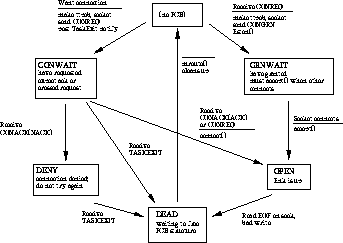Direct routing allows one task to send messages to another through a TCP link, avoiding the overhead of forwarding through the pvmds. It is implemented entirely in libpvm, using the notify and control message facilities. By default, a task routes messages to its pvmd, which forwards them on. If direct routing is enabled (PvmRouteDirect) when a message (addressed to a task) is passed to mroute(), it attempts to create a direct route if one doesn't already exist. The route may be granted or refused by the destination task, or fail (if the task doesn't exist). The message is then passed to mxfer().
Libpvm maintains a protocol control block (struct ttpcb)
for each active or denied connection,
in list ttlist.
The state diagram for a ttpcb is shown in
Figure ![]() .
To request a connection,
mroute()
makes a ttpcb and socket,
then
sends a
TC_CONREQ
control message to the destination via the default route.
At the same time,
it sends a TM_NOTIFY message to the pvmd,
to be notified if the destination task exits,
with closure (message tag)
TC_TASKEXIT.
Then it
puts the ttpcb in
state TTCONWAIT,
and calls
mxfer() in blocking mode repeatedly
until the state changes.
.
To request a connection,
mroute()
makes a ttpcb and socket,
then
sends a
TC_CONREQ
control message to the destination via the default route.
At the same time,
it sends a TM_NOTIFY message to the pvmd,
to be notified if the destination task exits,
with closure (message tag)
TC_TASKEXIT.
Then it
puts the ttpcb in
state TTCONWAIT,
and calls
mxfer() in blocking mode repeatedly
until the state changes.
When the destination task enters mxfer() (for example, to receive a message), it receives the TC_CONREQ message. The request is granted if its routing policy (pvmrouteopt != PvmDontRoute) and implementation allow a direct connection, it has resources available, and the protocol version (TDPROTOCOL) in the request matches its own. It makes a ttpcb with state TTGRNWAIT, creates and listens on a socket, and then replies with a TC_CONACK message. If the destination denies the connection, it nacks, also with a TC_CONACK message. The originator receives the TC_CONACK message, and either opens the connection (state = TTOPEN) or marks the route denied (state = TTDENY). Then, mroute() passes the original message to mxfer(), which sends it. Denied connections are cached in order to prevent repeated negotiation.
If the destination doesn't exist, the TC_CONACK message never arrives because the TC_CONREQ message is silently dropped. However, the TC_TASKEXIT message generated by the notify system arrives in its place, and the ttpcb state is set to TTDENY.
This connect scheme also works if both ends try to establish a connection at the same time. They both enter TTCONWAIT, and when they receive each other's TC_CONREQ messages, they go directly to the TTOPEN state.

Figure: Task-task connection state diagram